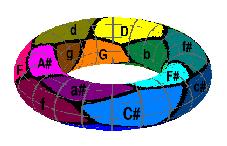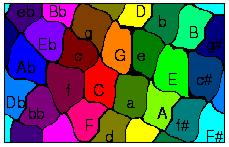This page is a copy to insure its continued existence.
CONSTANT Q PROFILES AND TOROIDAL MODELS OF INTER-KEY RELATIONS (ToMIR)
(from B. Blankertz, H. Purwins, and K. Obermayer. Toroidal models of inter-key relations in tonal music. In VI. International Conference on Systematic and Comparative Musicology. Oslo, 1999) Emergence of ToMIR from Psychoacoustic Experiments and Analysis of Western Tonal Music
The torus on the left is a geometric representation of the inter-key
relations of all major and minor keys, derived from psychoacoustic
experiments by (Krumhansl and Kessler 1982) (shown in 3-dimensional
representation). The torus on the right was derived solely from Alfred
Cortot's recording of the Chopin Preludes, op. 28, by the technique of
constant Q profiles. (shown in 2-dimensional representation: identify
left and right border and upper and lower border). Deriving a ToMIR from Basic Harmonic Relations.
Strip of key, derived from the charts of key regions in (Schoenberg 1969 ).
First Step: bending the strip three times.
Second step: Double appearances of minor keys are brought to accordance.
The borders of the tube show keys that are enharmonically equal. These
are united by bending the tube and gluing together its ends. This gives
a toroid surface around which the circles of fifths for major and minor
keys wrap three times before joining themselves.
REFERENCES
Krumhansl, C.L. and Kessler, E.J. 1982. Tracing the dynamic changes in
perceived tonal organization in a spatial representation of musical
keys, In Psychological Review 89(4): 334-368.
Schoenberg, A. 1969. Structural functions of harmony. Norton, New York. 2. ed.
1/19/2001
© Copyright. Robert Grace. 2002




